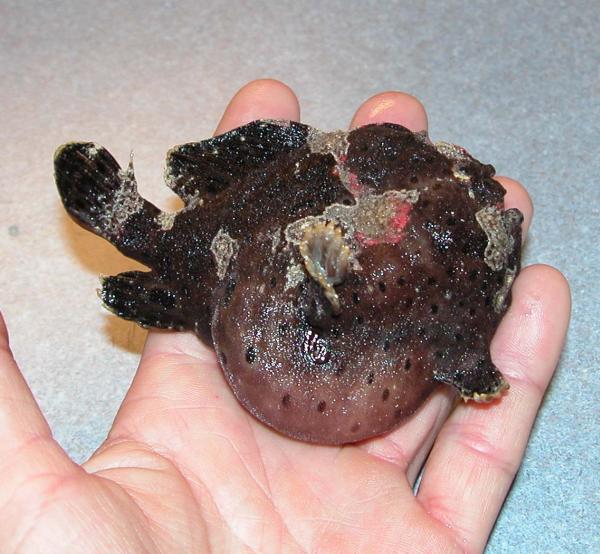Published in the Ocean Watch column, Honolulu Star-Advertiser © Susan Scott
April 4, 2008
While reading about frogfish this week, I found the following quote by Dutch artist Samuel Fallours, who visited Indonesia in the early 1700s: “I caught a frogfish on the sand and kept it alive in my house for three days; it followed me everywhere with great familiarity, much like a little dog.”
Wow, I want a fish like that.
OK, frogfish can’t really stroll around your apartment, but it’s easy to see how they can spark the imagination. These lumpy fish stand on feet with toes, carry a fishing pole with lure and eat fish as long as themselves. You won’t see any of this, though, because they’re virtually invisible.
Frogfish are also called anglerfish because they have a spine on their dorsal fin that rises over the fish’s head and hangs above the mouth. At the tip of this spine is a piece of flesh that looks wormlike in some species, fishlike in others.
When an edible-size fish swims by, the frogfish casts its line and moves the bait, jerking it like a writhing worm or moving it in little circles like a fish. Some frogfish throw the line back and forth, like a fly-fishing cast. Others hold it still.
At night an angling frogfish vibrates its lure. Feeling the quivers with its lateral line sensors, a squirrelfish might come to investigate. If so, it’s the squirrelfish’s last trip.
Squirrelfish are only one prey of frogfish; they’ll gulp down nearly any animal whole. When needed, the frogfish can expand its mouth 12 times its normal size.
This big appetite can be fatal. One 4.5-inch-long frogfish was found dead at Laysan after eating a 5-inch-long soldierfish. Another frogfish died with an inflated porcupinefish in its stomach.
Usually, though, frogfish cope well with their big catches, even venomous ones. The striated frogfish (a Hawaii species) routinely eats scorpionfish with no ill effects.
No human or marine animal can see a frogfish strike because the lunge is one of the fastest in the fish world. In six-thousandths of a second, the frogfish’s jaws project the mouth forward, and poof, the prey is gone.
If a frogfish loses its fishing pole to a big fish, it grows a new one. This can take four to eight months, but baitless frogfish still catch prey because of their incredible ability to mimic invertebrates, seaweed and coral. A frogfish tucks into a nook, changes colors to match the background and then ambushes passing fish and invertebrates.
Sometimes fish, shrimp or crabs think a camouflaged frogfish is shelter. Big mistake. Frogfish also trick researchers: The striated frogfish has been given 25 different scientific names.
Frogfish blending is total. Even with a fellow diver pointing, I’ve been unable to see a frogfish just inches from my face. Photos of these fish can be equally hard to make out.
Of the world’s 43 frogfish species, Hawaii hosts 12. The smallest one here is 1.6 inches long; the largest grows to 15 inches. One, the freckled frogfish, reaching 4.7 inches, is found only in Hawaii.
Frogfish walk slowly around the reef, using their stubby pectoral fins like legs and the fin tips like pointy toes. They do it, however, only underwater.
Besides fish walking around his house, Samuel Fallours said he had a mermaid in his bathtub and lobsters in his trees. I bet he also ate loads of mushrooms.
 I found this live frogfish on Kailua Beach.
I found this live frogfish on Kailua Beach.
Frogfish often inhale air when exposed and it gets trapped inside their bodies.
That happened to this frogfish. It lived for a few days in my aquarium and then died.